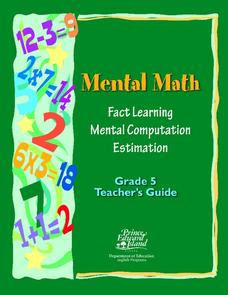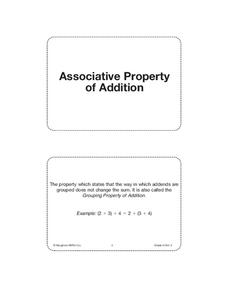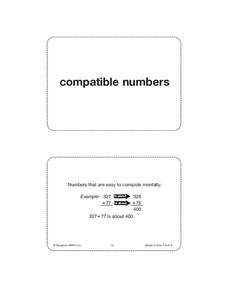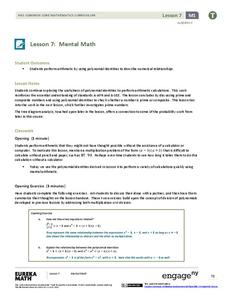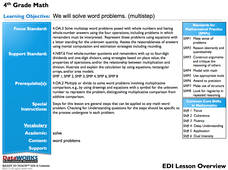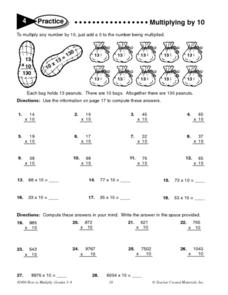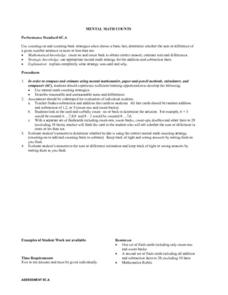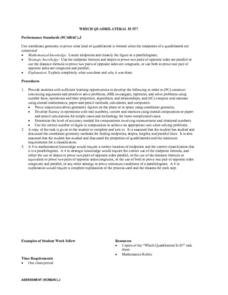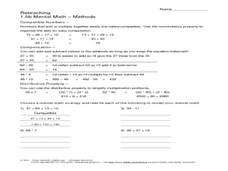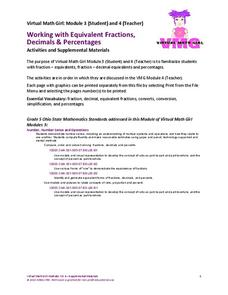Prince Edward Island
Fact Learning, Mental Computation, Estimation
Need help with mental math in your classroom? This guide is full of tips, tricks, and examples to help the teacher encourage learners to use their brain instead of a calculator. Practice problems are included with reasons how...
For the Teachers
$1 Math
Captivate your class by having them find the value of their names, different zoo animals, musical instruments, etc.,with a mental math lesson. Using the coding formula listed, children learn to fluently estimate and calculate...
EngageNY
The Division Algorithm—Converting Decimal Division into Whole Number Division Using Mental Math
Make math much simpler with mental math methods. The 16th installment in a series of 21 looks at ways scholars can apply mental math to convert division problems into easier problems with the same quotient. Multiplying or dividing both...
Houghton Mifflin Harcourt
Unit 2 Math Vocabulary Cards (Grade 3)
A set of third grade math vocabulary cards include topics that range from addition properties to terms like estimate and fact family. Each sheet has two cards on it. The top half is the word printed in bold text,...
Houghton Mifflin Harcourt
Unit 8 Math Vocabulary Cards (Grade 3)
A set of 9 math vocabulary cards prompts young mathematicians to master division concepts. The top half of each sheet contains the word printed in bold text, while the bottom half has the definition card.
Curated OER
Math: Navigating the World Around Me
Young mathematicians research and discuss real world math word problems and ways in which they apply math concepts in their everyday lives. They create a storyboard of a math word problem from which they create a slide for a multi-media...
Savvas Learning
How Many Hundreds?
Mental math skills are really important to develop. Kids practice metal computation by first adding the hundreds then the tens and ones. There are nine addition and nine subtraction problems to solve. This attractive worksheet is...
Curated OER
Take Math Shopping!
Percents, estimation, and comparative analysis become more understandable when they are used in-context at the grocery store.
EngageNY
Mental Math
Faster than a speedy calculator! Show your classes how to use polynomial identities to multiply numbers quickly using mental math.
DataWorks
4th Grade Math: Multi-Step Word Problems
Solving word problems requires reading comprehension and math computation. Through an interactive slideshow presentation, fourth graders observe and follow each step toward solve multiplication and division word problems.
Curated OER
Factor Pairs
This presentation covers a lot of ground. Square numbers, metal math computations, commutative property, ordering positive and negative integers, factoring, and real world problem solving are all covered. Use over the course of several...
Curated OER
Multiplying by 100
In this math activity, students learn the tricks to multiply any number by 10, 100 or 1000. There are 75 problems on 3 pages, both written horizontally and vertically with instructions and picture illustrations to help students.
Maths Blog
Adding/Subtracting Whole Numbers in Your Head
Exercise those mental math muscles! This worksheet contains 10 addition and 10 subtraction problems which require learners to compute sums or differences in their heads. A quick review at the top of the page provides a strategy based on...
Curated OER
Mental Money
Students access prior knowledge to round numbers and add decimals. For this mental math lesson, students share the book Betcha and calculate estimates for three jars based on the book. Students calculate money answers based on coins...
Curated OER
Mental Math Counts
Students use mental math. They describe reasonable and unreasonable sums and differences. Students use mental math to find the sums and differences of addition and subtraction facts at random. They solve addition and subtraction facts...
Curated OER
Which Quadrilateral Is It?
Young scholars prove conjectures about geometric figures on the plane or in space using coordinate geometry. They develop fluency in operations with real numbers, vectors and matrices using mental computation or paper-and-pencil...
Curated OER
Mental Math Methods
In this mental math worksheet, students use mental math methods to solve problems. Students complete 1 addition, 1 multiplication, and 1 subtraction problem using these methods.
Curated OER
Two-Digit Subtraction With and Without Regrouping
Second graders subtract two-digit numbers. In this mathematics lesson, 2nd graders subtract both with and without regrouping. Students use manipulatives and place value mats to assist in problem solving.
Curated OER
All A-buzz About Math
Second graders participate in Math-Eze activities to comprehend word problems. In this word problem lesson, 2nd graders recognize why a hexagon is the best shape for a beehive. Students calculate how far bees must travel to find 2 lbs....
PBS
Working With Equivalent Fractions, Decimals and Percentages: Activities and Supplemental Materials
Reinforce math concepts using six worksheets that coincide with Virtual Math Girl's video instruction. The practice pages' objectives include writing equivalent fractions, decimal equivalents, and converting percents to decimals and...
Illustrative Mathematics
Finding a 10% increase
A quick problem to test your mathematicians' knowledge on percent increase. Two different solutions are provided, mental math and computing. Ask your learners to include a description of what they did to supplement their answer.
Curated OER
Estimate, Solve, and Check
Young scholars estimate, solve, and check a series of addition and subtraction number and word problems. They write their estimates on a recording sheet, compute and write the answer in the next column, and check their answer with a...
Curated OER
Rice Cookies Addition
Fourth graders practice adding rice cookies. In this mental math lesson, 4th graders get into groups and call out numbers to each other to add mentally. Students use the rice cookies to show the answer.
Curated OER
WINDMILL POWER
Students study operations with real numbers using mental computation or paper-and-pencil calculations. They judge the reasonableness of numerical computations and their results. They set up and solve proportions for direct and inverse...


